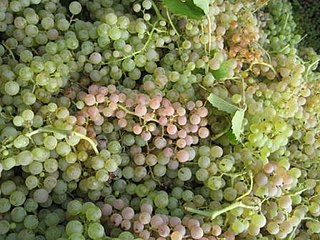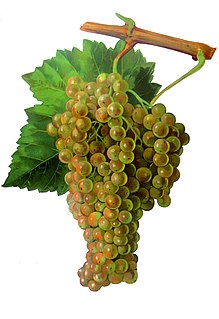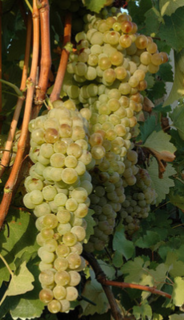
Garganega is a variety of white Italian wine grape widely grown in the Veneto region of North East Italy, particularly in the provinces of Verona and Vicenza. It is Italy's 6th most widely planted white grape. It forms the basis of Venetian white wine Soave and is also a major portion of the blend used to make Gambellara.

Trebbiano is an Italian wine grape, one of the most widely planted grape varieties in the world. It gives good yields, but tends to yield undistinguished wine. It can be fresh and fruity, but does not keep long. Also known as ugni blanc, it has many other names reflecting a family of local subtypes, particularly in Italy and France. Its high acidity makes it important in Cognac and Armagnac productions.

Vermentino is a light-skinned wine grape variety, primarily found in Italian wine. It is widely planted in both Sardinia and Liguria, to some extent in Corsica, in Piedmont under the name Favorita, and in increasing amounts in Languedoc-Roussillon. The leaves are dark green and pentagonal. The grapes are amber-yellow and hang in pyramidal bunches. The vines are often grown on slopes facing the sea where they can benefit from the additional reflected light. The Vitis International Variety Catalogue now gives Italy as its origin.

Gaglioppo is a red wine grape that is grown in southern Italy, primarily around Calabria. The vine performs well in drought conditions but is susceptible to oidium and peronospora. The grape produces wine that is full-bodied, high in alcohol and tannins with a need for considerable time in the bottle for it to soften in character. It is sometimes blended with up to 10% white wine.

Nerello is a name given to two varieties of red wine grapes that are grown primarily in Sicily and Sardinia.

Ciliegiolo is a variety of red wine grape from Italy, named after the Italian for 'cherry'. It is a minor component of traditional blends such as Chianti, but interest has revived in recent years. In Umbria it is made into a light quaffing wine, while in Tuscany it is made into a bigger, more structured style.

Albana is a white Italian wine grape planted primarily in the Emilia-Romagna region.
Albillo or Albillo Real is a white Spanish wine grape variety planted primarily in the Ribera del Duero region, and also in Madrid, Ávila and Galicia. The grape has mostly neutral flavors with a light perfume aroma. It has a high glycerol index which confers smoothness to the wines.
Erbaluce or Erbaluce bianca is a white Italian wine grape grown primarily in the Piedmont region around Caluso, in Canavese. In addition to dry table wines, it is used to make sweet wines with deep golden coloring, such as passito. The grape has a long history in the Piedmont region, with the first written record dating to 1606, and most likely originated in the alpine hills of northern Piedmont.

Frappato di Vittoria or Frappato is a red Italian wine grape variety planted primarily in Sicily. As a varietal, Frappato produces light bodied wines with a distinct grapey aroma. It is most commonly seen as a component of Sicily's only DOCG wine, Cerasuolo di Vittoria, which consists of 30-50% Frappato and 50-70% Nero d'Avola.

Incrocio Manzoni or Manzoni grapes is a family of grape varieties named after Professor Luigi Manzoni (1888-1968) of Italy's oldest school of oenology located in Conegliano, in the Veneto region. Manzoni created the new grape varieties by selecting, crossing and grafting vines from various vineyards during the 1920s and 1930s. The family includes both white and red grape varieties. Although most Manzonis are grown in northeastern Italy, they are mainly grown in the Piave area of Province of Treviso and are only now starting to be sold commercially in Europe and the United States.
Girò is a red Italian wine grape variety that is grown on Sardinia and is used mostly in the production of fortified wines in the Giro di Cagliari Denominazione di origine controllata (DOC). The grape was once widely planted throughout Sardinia but its plantings were decimated when the phylloxera epidemic hit the island at the end of the nineteenth century. At the turn of the 21st century there were 552 hectares of the grape planted throughout Italy, mostly in the Sardinian provinces of Cagliari and Oristano.
Albaranzeuli bianco is a white Italian wine grape variety that is grown primarily in Sardinia. Ampelographers use to believe that the grape was originally Spanish in origin and was introduced to the island when it was ruled by the Crown of Aragon. Recent DNA profiling has suggested that the grape may have originated on the island as a crossing between the red Sardinian wine grape Girò and the Spanish table grape Molinera, known locally as Pansa Rosa di Málaga and distinct from the Veneto wine grape Molinara that is used in Amarone. A pink skinned grape known as Albaranzeuli nero is also found in Sardinia but its exact relationship to Albaranzeuli bianco is not yet clear.
Marzemina bianca is a white Italian wine grape variety that is grown in the Veneto region of northeastern Italy. Ampelographers believe that the grape is a natural crossing of the Trentino wine grape Marzemino and the Soave wine grape Garganega. This parent-offspring relationship between Marzemina bianca and Marzemino makes the variety distinct from grapes like Pinot blanc and Grenache blanc which are other color mutations of Pinot noir and Grenache, respectively. DNA analysis has confirmed that the Veneto grape Raboso Veronese is the offspring of Marzemina bianca and Raboso Piave.
Cascarolo bianco is a white Italian wine grape variety that is grown primarily in the Piedmont wine region of northwest Italy. The grape has a long history in the region and was noted in 1606 by Giovanni Battista Croce, vineyard owner and official jeweler to Charles Emmanuel I, Duke of Savoy, as growing in the hills around Torino and producing wine of high esteem. It was once thought that Cascarolo bianco was the same variety as the Hungarian wine grape Fehér Gohér but DNA profiling in the early 21st century determined that the two grapes are unrelated. Today ampelographers believe that the grape is an offspring of the Swiss wine grape Rèze with DNA evidence suggesting some relationship with another white Piedmontese grape, Erbaluce.
Minella bianca is a white Italian wine grape variety that is indigenous to the island of Sicily where it is grown in the foothills of Mount Etna. The name Minella is derived from the Sicilian word minna to which the berries have some resemblance due to their elongated shape. Minella bianca is very rarely seen as a varietal and is most often used in field blends with Carricante and Catarratto bianco.
Rossese bianco is a white Italian wine grape variety that is grown around the communes of Roddino and Sinio in the Langhe region of the province of Cuneo in Piedmont. While sharing the name Rossese with several Italian varieties, DNA profiling has shown that all these varieties have unique genetic profiles and appear to have no close relationship to each other.
Aglianicone is a red Italian wine grape variety that is grown in the Campania and Basilicata region of southern Italy. Despite the similarities in naming, Aglianicone is not a clonal mutation of Aglianico but DNA analysis does suggest a close genetic relationship between the two varieties.
Albanella is a white Italian wine grape variety that is grown in the Marche region where it is a primary component in the white Denominazione di Origine Controllata (DOC) wines of Colli Pesaresi. The grape is often confused with the similarly named Sicilian wine grape Albanello and was long thought to be identical to the Tuscan wine grape Trebbiano but has established through DNA analysis to be its own distinct variety.
Bonda is a red Italian wine grape variety that is grown in the Aosta Valley region of northwest Italy around the communes of Châtillon and Quart. Historically the grape has been confused with another grape of Aosta, Primetta, but DNA analysis in the early 21st century showed that the two grapes were distinct and not closely related. Despite being known under the synonym of Prié rouge, Bonda is not a color mutation of Prié blanc nor do the two grapes seem to be closely related.









